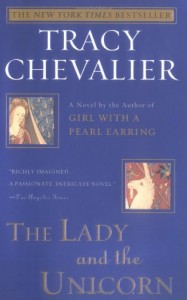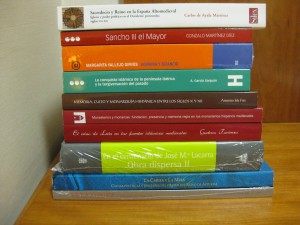I am that strange person who did not like The Girl with the Pearl Earring, but loves the rest of Tracy Chevalier’s work. This goes true for her The Lady and the Unicorn, which I just finished tonight. To be honest, I started it tonight too. A story of the creation of the famous Unicorn tapestries, now housed at the Musee de Cluny, in Paris, it is that good.
If you read other reviews of this book, you will find that their authors can’t resist the chance to use “tapestry” metaphors when describing Chevalier’s skill. “A deftly woven tapestry,” “not a stitch is missing,” they write. However, this attention to the book as the fully-realized production of a single person, an “author,” seems to miss the exact point Chevalier is trying to make about artistic creation. Nicholas des Innocents, the painter who designed the tapestries, is at the heart of her book, and it is he whom a modern audience would credit with being their “author.” But the story is designed to show us how these wonderful examples of the fifteenth-century art of weaving are in fact the product of many, many hands and brains and sources of inspiration. Chevalier reveals to us, not only the contribution of the designer and the members of Brussels atelier that weaves the tapestries, but the the role of the patrons who debate over the design; the merchant who acts as go-between, hiring the designer and arranging for his work to be made a reality; the women who serve as muses; the servants who care for the house so the work can be done; the English wool workers who ship their cloth to Ostend; and even the unappealing Jacques Le Boeuf, smelly because of the urine used to fix the woad that gives the beautiful blues to the tapestries.
It is easy to suppose that Chevalier sees her own creation as an author in the same light. The fantasy is of an author who toils alone and creates a book as a pure, solitary act, the work of her brain transmitted through her hands onto the page. The reality is that Chevalier’s book had as many hands in it as the tapestries themselves: an agent and an editor and maybe other readers who suggested revisions and made comments at an early stage (Chevalier thanks a long list of people in her acknowledgements), and closer to publication, there was a copyeditor and proofreader. Someone designed the cover (actually, his name is Richard Hasselberger — it is on the back flap of the dust jacket — and it is a very nice cover indeed) and took the author photo (Jerry Brauer) and created the layout and chose the type face and given that this novel followed the huge success of Girl with the Pearl Earring there was probably a substantial group in charge of publicity and promotion. And we can add to this list the booksellers who hand-sold it, the librarians who recommended it, and all the people who reviewed it. All of these were needed to make The Lady and the Unicorn what it is. And none of this takes away from Chevalier’s work.






